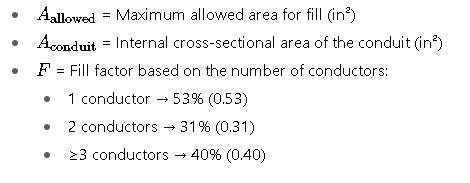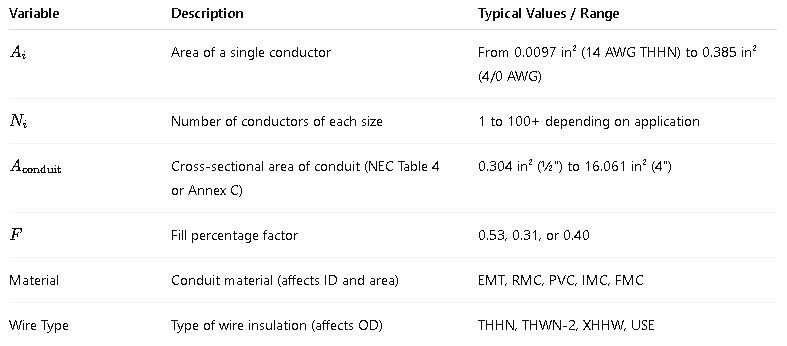Correct conduit sizing ensures safe, efficient, and NEC-compliant electrical installations in residential and industrial settings.
This guide explains conduit sizing principles with NEC-based tables, formulas, and real-world applications for accuracy.
Conduit Size for Electrical Cables (NEC)
What conduit fill percentage should I use?
Are cable diameters exact?
Does this replace NEC Annex C?
Jam ratio considerations
NEC-Based Conduit Fill Tables – Most Common Configurations
The NEC (particularly Chapter 9, Table 1, and Annex C) provides the maximum number of conductors allowed in different conduit types, depending on fill percentage (typically 40% for three or more conductors). Below are curated and extended tables showing popular wire sizes, types, and conduit materials.
Table 1: Common THHN/THWN-2 Copper Conductors in EMT Conduit (40% Fill)
| Conductor Size (AWG) | Conductor OD (inches) | EMT ½” | EMT ¾” | EMT 1″ | EMT 1¼” | EMT 1½” | EMT 2″ |
|---|---|---|---|---|---|---|---|
| 14 | 0.111 | 9 | 16 | 26 | 44 | 60 | 102 |
| 12 | 0.130 | 7 | 12 | 20 | 34 | 46 | 78 |
| 10 | 0.164 | 5 | 9 | 15 | 26 | 36 | 60 |
| 8 | 0.216 | 3 | 5 | 9 | 16 | 22 | 36 |
| 6 | 0.254 | 2 | 4 | 7 | 13 | 18 | 30 |
| 4 | 0.343 | – | 2 | 4 | 8 | 11 | 19 |
| 3 | 0.385 | – | – | 3 | 7 | 9 | 16 |
| 2 | 0.430 | – | – | 2 | 6 | 8 | 14 |
| 1 | 0.480 | – | – | – | 5 | 7 | 12 |
| 1/0 | 0.530 | – | – | – | 4 | 6 | 10 |
| 2/0 | 0.580 | – | – | – | 3 | 5 | 9 |
| 3/0 | 0.630 | – | – | – | 3 | 4 | 8 |
| 4/0 | 0.680 | – | – | – | – | 3 | 7 |
Reference: NEC Chapter 9, Table 1 and Annex C
Table 2: Rigid PVC Conduit Size vs Maximum Number of 12 AWG THHN Conductors
| Rigid PVC Size | Internal Area (in²) | Max 12 AWG (THHN) @ 40% |
|---|---|---|
| ½” | 0.292 | 6 |
| ¾” | 0.533 | 10 |
| 1″ | 0.864 | 17 |
| 1¼” | 1.497 | 29 |
| 1½” | 2.036 | 39 |
| 2″ | 3.356 | 64 |
| 2½” | 5.858 | 112 |
| 3″ | 8.784 | 168 |
| 3½” | 11.945 | 228 |
| 4″ | 16.061 | 306 |
Table 3: Common Trade Sizes and Their Cross-Sectional Areas (Per NEC)
| Conduit Type | Trade Size | Internal Diameter (in) | Cross-Sectional Area (in²) |
|---|---|---|---|
| EMT | ½” | 0.622 | 0.304 |
| EMT | ¾” | 0.824 | 0.533 |
| EMT | 1″ | 1.049 | 0.864 |
| EMT | 1¼” | 1.380 | 1.497 |
| EMT | 1½” | 1.610 | 2.036 |
| EMT | 2″ | 2.067 | 3.356 |
| PVC Schedule 40 | 1″ | 1.029 | 0.832 |
| Rigid Metal | 1″ | 1.063 | 0.880 |
Fill percentages: NEC Table 1 prescribes:
- 1 conductor = 53% fill
- 2 conductors = 31% fill
- ≥3 conductors = 40% fill
Key Formulas for Conduit Size Calculation (NEC-Based)
Conduit sizing under NEC guidelines involves calculating the total cross-sectional area of all conductors and comparing it against the allowable fill percentage of the conduit type. The following formulas are used in conduit fill and sizing calculations.
Formula 1: Total Conductor Area

Formula 2: Maximum Allowable Area for Conduit (Based on Fill)

Formula 3: Required Conduit Size
To find the minimum conduit size, solve for the smallest conduit whose  meets:
meets:
Variables and Their Typical Values

For THHN/THWN-2 copper conductors, you can use NEC Chapter 9 Table 5 to obtain nominal diameters and convert them to areas using:
NEC References Used in the Formulas
- NEC Chapter 9 Table 1: Conduit fill percentages
- NEC Chapter 9 Table 4: Conduit dimensions (ID, area)
- NEC Chapter 9 Table 5: Wire dimensions
- NEC Annex C: Maximum number of conductors by size and conduit type
Important Notes on Sizing Practice
- Always consider derating factors and temperature correction if ambient conditions are extreme.
- Bonding and grounding conductors must be included in the area calculation.
- For parallel runs, calculate each conduit independently.
- In wet locations, use THWN-2 or XHHW insulation types.
- For flexible conduit (FMC/ENT), allowable fill may differ. Refer to special tables.
Frequently Asked Questions (FAQ) – Conduit Size for Electrical Cables Calculator – NEC
What is the standard conduit fill percentage according to the NEC?
The NEC (National Electrical Code) specifies maximum conduit fill percentages in Chapter 9, Table 1:
- 53% for 1 conductor
- 31% for 2 conductors
- 40% for 3 or more conductors
These limits ensure sufficient space for heat dissipation and ease of wire pulling.
How do I calculate the required conduit size for multiple conductors?
You must:
- Determine the cross-sectional area of each conductor (from NEC Table 5 or manufacturer data).
- Sum the areas of all conductors.
- Divide the total area by the allowed fill percentage.
- Select the smallest conduit whose internal area meets or exceeds that value (NEC Table 4 or Annex C).
Can I install different wire sizes in the same conduit?
Yes, different wire sizes can share a conduit if:
- All insulation types are rated for the same temperature and environmental conditions.
- You calculate and include the area for each conductor size individually.
- The total area does not exceed NEC fill limits.
Which NEC tables are used in conduit sizing?
For accurate conduit size calculations per NEC:
- Table 1, Chapter 9: Maximum fill percentages
- Table 4, Chapter 9: Conduit dimensions (EMT, PVC, RMC, etc.)
- Table 5, Chapter 9: Conductor dimensions (THHN, THWN, XHHW, etc.)
- Annex C: Pre-calculated max conductors per conduit type and size
What happens if a conduit is overfilled?
Overfilling a conduit can cause:
- Overheating due to limited heat dissipation
- Insulation damage during pulling
- Code violations that may void warranties or inspections
- Electrical faults or reduced system lifespan
Always stay within NEC limits and consider using a larger conduit for long or complex runs.
Does the type of conduit affect the fill capacity?
Yes. Each conduit material has different internal diameters and cross-sectional areas, even for the same nominal trade size. For example:
- 1″ EMT has ≈ 0.864 in² area
- 1″ PVC has ≈ 0.832 in² area
- 1″ RMC has ≈ 0.880 in² area
Always consult NEC Table 4 for accurate data per conduit type.
Are grounding conductors included in conduit fill calculations?
Yes. The equipment grounding conductor (EGC) must be included when calculating the total conduit fill area. Its cross-sectional area is based on wire size and insulation type, just like any current-carrying conductor.
Is there a tool or calculator that simplifies conduit sizing?
Yes. A Conduit Size for Electrical Cables Calculator – NEC can automate:
- Conductor area lookup
- Conduit area comparison
- Fill factor adjustment
These tools help prevent code violations and speed up design tasks. You can find online calculators or integrate one into your own design platform.
Where can I find the full NEC documentation?
The NEC (NFPA 70) is available for public access via the NFPA’s official site. Always refer to the latest edition applicable to your jurisdiction (e.g., 2023 NEC).
How do I handle conduit fill in parallel conductor installations?
For parallel runs:
- Each parallel set of conductors must be installed in separate conduits.
- Calculate fill for each conduit independently.
- Ensure equal conductor lengths and sizes to maintain load balance.
This is critical in feeders and motors per NEC 310.10(H).



